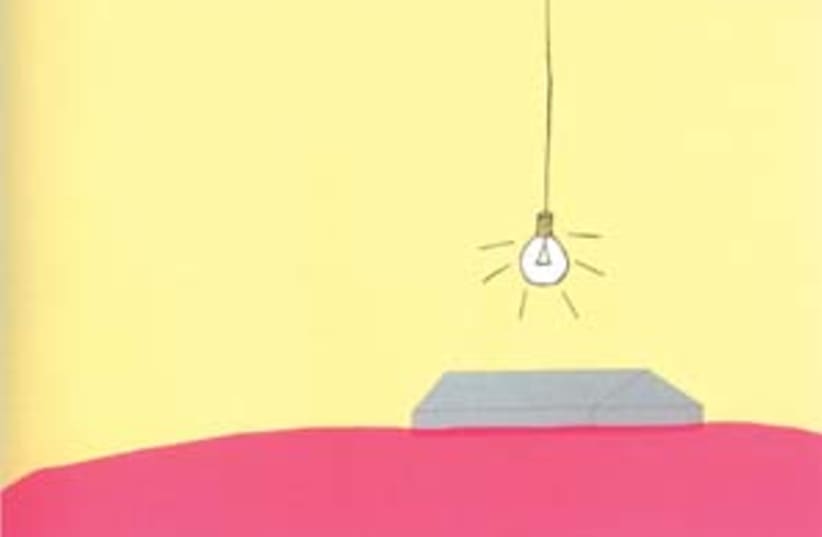Closing down Jerusalem
Summer and circumstances have overtaken the art field in Jerusalem.
Summer and circumstances have overtaken the art field in Jerusalem. At the Israel Museum, now embarked on a three-year redesign, the main exhibit still on view is the huge grab-bag of surrealist and Dadaist paintings and objects that opened in the Weisbord Entrance Pavilion over three months ago. At the Jerusalem Artists House, another continuing show is One For All, a group exhibition of prizewinners in the latest competition organized by the Adi Foundation under the auspices of the Israel Museum. A mix of painting, photography and sculpture, the Adi show is devoted to a program that endeavors to find links between art and Jewish traditions. As I wrote in my review of the exhibition some months ago, it's worth a visit, if only to see a clever typographical metal sculpture by the brilliant Zelig Segal, and a pile of iron houses of varied ethnic symbolism by Jack Jano.
In addition, two small shows opened at the Artists House last weekend. The first, of small paintings by Sara Zilberstein, is made up of meticulous small-format depictions of ciphers for female figures as leaves blown in the wind, or, if you like, of tiny nudes budding in new-found freedom. Two other themes on view are of other-worldly flowers and variations on the form of the butterfly.
All of the paintings have meticulously handled pointillist backgrounds and all are of a fairly similar warm-hued palette. The flowers are particularly well-done, but the show as a whole is self-mannerist.
Down in the entrance gallery is yet another tedious show of projected images in the interminable Nidbach series devoted to recent art college graduates. However, this time the stills projected on walls and floor are cleverly manipulated by Beit Berl graduate Alma Schneor to undergo changes through repositioning, refocusing or via montage. It's clever, but slight. Is this all they are teaching in art colleges these days?
This venue will be closed throughout August and will reopen in early September with a show by artists newly admitted to the Jerusalem Artists Association.
The outlook for this veteran Jerusalem cultural institution is bleak.
Apart from attempts at back-stabbing by municipal officials dismayed by the Artists House's liberal approach to exhibition themes, the ongoing elimination of kerbside parking by traffic planners bent on closing downtown Jerusalem to private transport has made a visit to the Artists House a Sisyphean task. The only time to see a show there is on Saturday morning, when a nearby private parking lot, always full on weekdays, is left open.
The planners, I am told, include non-residents of Jerusalem who still trumpet the merits of public transport and the vaunted new tram system. The inauguration of the latter, postponed time after time, has now been set for 2010, though there is little likelihood that even one branch of it will be operative by then.
Not just the survival of the Artists House is threatened, but that of all the businesses in downtown Jerusalem. Perhaps some future municipal administration will do away with the pedestrian plazas and restore the eliminated parking spaces. Perhaps.
THE VETERAN and admirable Jerusalem Print Workshop at Rehov Shivtei Yisrael 38, a location also without parking, has a chameleon-like talent for changing its name every time a new donor turns up to keep it alive. It is now called the Djanogly Print Workshop, Jerusalem - Bernard and Barbra Osher Art Center. Just as this page was going to press, I received the illustrated catalog of its summer show of prints by Etty Abergel, Nelly Agassi, Hannah Farah, Hila Lulu Lin, Uriel Miron and Yael Robin.
The fare is varied and skilled and looks like a show worth visiting if you can afford a taxi. Viewing is from 8 a.m. to 3 p.m. Sundays through Thursdays.
THE MUSEUM for Islamic Art in Jerusalem's Rehov Palmah today opens a show of Anatolian kilims from the Berlin Collection of Georg and Birgit Rabe. More about this show in our next column.
THE ISRAEL Museum has announced the arrival of an important donation: Gustave Courbet's Jura Landscape with Shepherd and Donkey, 1866, the gift of Ivan and Lisa Kaufman, New York, to the American Friends of the Israel Museum.
Gustave Courbet (1819-1877) grew up in Ornans near the Swiss border, and the nearby Jura mountain range and valley count among his favorite sites for landscape painting. This work introduces Gérôme, Courbet's famous donkey, purchased by him in November 1864 in exchange for a landscape painting.
This valley was depicted time and again by Courbet but many of the late works were painted by a variety of his assistants when Courbet was strapped for cash to pay a series of state fines.
The Jura region, also known as "Free Country" because of its history of political independence from Paris-centered France, reflects Courbet's own carefully cultivated personality - his independent spirit, ardent socialism, down-to-earth behavior and self-proclaimed motto, "shout loud and walk straight." Known as a firebrand and and rabid anti-cleric, he was active in the revolution of 1848 and was imprisoned and fined for damaging Napoleon's column in the Place Vendome during the Commune of 1871. He eventually fled to Switzerland and died there. He thus missed the advent of French Impressionism, which had benefited from his unorthodox approach.
Courbet made some wonderful seascapes, was always happy to shock and painted a number of erotic nudes. In 1866 he also created his provocative lesbian scene. In early April of that year he had a breakthrough at the Paris Salon, where two of his works - one of them a landscape - were favorably received; the state acquired his landscape composition The Shaded Stream (1865).

